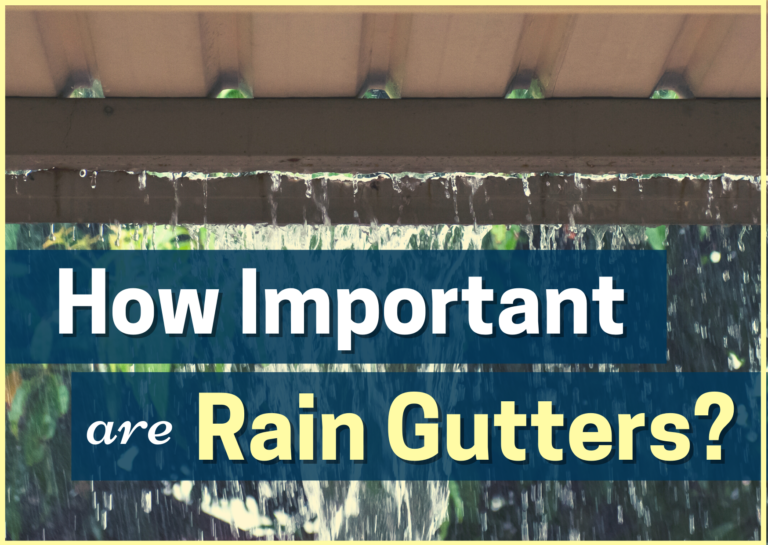
APRON FLASHING : The installed horizontal flashing where its top end part of the slope meets a vertical projection like a parapet wall or a chimney

BARGE : The finishing at the gable end of a roof; fixed parallel to the slop of the roof
BMT : Base Metal Thickness
BOX GUTTER : A gutter that’s not an eave, secured at the base of two opposing roof slopes.
BID : A contractor’s formal offers per the project’s specifications. He bids the project based on the terms and conditions stated in an offer.
BOX MITER : Secures two pieces of gutter at a 90-degree angle outside or inside.
BRICK MOLD : Trim used on the exterior door jamb that siding butts to.
BUILT-UP ROOF : A roofing composed of three to five layers of asphalt felt laminated with pitch, coal tar, or asphalt. Its top is finished with crushed gravel or slag. This is used on low-pitched or flat roofs.

CAP FLASHING : The part of the flashing secured to a vertical surface to keep water from migrating behind the base flashing.
CAPPING : The cover on the top portion of the gap that weatherproofs. It’s usually placed at the ridge of a pitched roof.
CHIMNEY : A tiny gutter found on the upper portion of a chimneystack
CGI : Corrugated Galvanized Iron or Steel. See Corrugated Roofing.
CLADDING : The sheeting that encloses a building’s roofing and walling.
COUNTER FLASHING : A flashing made to look like a cover only, placed over a separate upstand.

DOWNPIPE : The pipe that carries the rood water from roof catchments and gutters to storage tanks and drains.
DRAINAGE : A system of drainpipes and gutters that carry water away from the foundation of a house.
DRIP EDGE : A non-corrosive, non-staining material used along rakes and eaves to allow water run-off to drip clear of underlying construction easily.
DROP : Check Pop.
DROP OUTLET : A formed piece that serves as the whole from which the water travels from the horizontal section of the gutter to the downspout.

EAVES GUTTER : The roof gutter secured at the eaves overhang.
ELBOW : A pre-finished angled piece that directs water flow.
ELECTROLYTIC CORROSION (galvanic) : The corrosion resulting from the contact of two different metals when an electrolyte (such as water) is present.
END CAP : A flat formed piece placed at the end portion of a gutter section.
EXPANSION JOINT : The joint seen in a long run of cladding, flashing, or gutter, and is designed to allow for efficient thermal expansion and contraction.

FALL (Slope) : The gutter or roof’s slope, usually expressed in degrees, or as a ratio of vertical height to horizontal distance.
FASCIA (board) : A flat board running horizontally along the eaves of a roof, capping the ends of the roof rafters so that the roof edge has a more finished look. The board also serves as the base for attaching gutters.
FIXING SCREWS : Clouts or nails used to secure the cladding to a building structure.
FLASHINGS : Usually metals, flashings are used to waterproof the junction between two intersecting roofs and wall surfaces. At a masonry wall, they are often built into the mortar.

GALVANIZED STEEL : Steel sheeting protected against corrosion by a zinc-coating applied by the continuous hot-dip process.
GIRTH : The blank strip’s width from which a profile is rolled (usually refers to flashings and gutters).
GUTTER : The horizontal channels installed at the edge of the roof. It carries rainwater or melted snow away from the house.

HANGER : Flat strap installed under the roofing materials. It holds up the horizontal section of the gutter.
HANGING FLASHING : Front, side, or back cover piece used to prevent entry of water between abutting surfaces and other gutters, soakers, and flashings.

INSIDE MITER BOX : A corner piece of the horizontal section that is deflected in.

LEADER : A pipe carrying rainwater from the gutter to the ground, wells, or sewers.

MANSARD : A roof built at two pitches; the steeper one commencing at the eaves, and the flatter one finishing at the ridge.
MITERED CORNER : Where two pieces of gutter come together and joined by either a strip meter or box miter.

NOZZLE : See Pop.

OFFSET : A pipe fitting that guides the downpipe from the gutter, under the eave’s soffit and down a wall.
OILCANNING : Variation from the sheet metal’s flatness, creating undulations along the surface. This results to poor appearances and even possible ponding.
OUTSIDE MITER BOX : The corner piece of the horizontal section that is deflected out.

PAN : Built-in gutters are also called pan gutter or box gutters and are considered concealed roof drainage systems since they are not easily visible.
PARAPET : The wall on a building’s parameter projecting the lines of the eaves.
PENETRATION : The projection through the roof, e.g. chimney, vent pipe, or roof light
PIERCE-FASTENED : A method of fixing cladding though a screw or nail which pierces the cladding
PITCH : The angle wherein the horizontal portion of the gutter is tilted to force water to flow to the downspout
PONDING : Pooling of undrained water on a roof
POP : The short fitting found in a gutter sole where rainwater leaves the gutter.

RAINHEAD : A box-shaped receptacle that is sometimes used between downpipes and gutters, providing added overflow point.
R-VALUE : A value given for the heat transfer resistance of a roof or wall system.
RIB : A longitudinal upstand in cladding.
RIDGE CAPPING : A formed metal designed to weatherproof the junction at the apex of opposing roof slopes.
RUN : The length of the horizontal portion of a gutter.

SADDLE STRAP : See straps.
SARKING : A membrane to collect and discharge clear of the structure any water that can potentially penetrate a roof or a wall cladding.
SHOE : A fitting in a downpipe designed to alter the direction of the downpipe by about 45 degrees.
SOAKER (Gutter) : A small gutter found on the upper side of the chimneystack.
SOAKER (Flashings) : The side cover pieces extended over the roof cover. It is over-flashed with a hanging flashing. Its formed metal design ensures to weatherproof the perimeter of the roof penetrations and protrusions. The flashings are normally positioned under, instead of over, the surrounding metal roof.
SOLE : The internal, bottom surface of the roof gutter.
SPLASHBLOCK : A concrete or plastic surface placed under a downspout to steer water away from the house.
SPREADER : The downpipe-tee or elbow fixed at 90 degrees to the roof slope used to spread storm water over a greater area of the roof.
SPOUTING : See Gutter.
STRAP : Flat hangers that are nailed into the house to secure the downspouts in place.
STRIP MITER : Adjoins gutters at an angle 90 degrees or 135 degrees inside or outside.
SUMP : The roof gutter pit used in connecting downpipes to internal roof gutters.

TABBED MITER : Used to adjoin two gutters at a compound angle or non-standard.
THERMAL STRESS : Stress caused because of the contraction and expansion caused by temperature changes.
TRAYS : See Pan.

VALLEY GUTTER : The gutter at the bottom intersection of two sloping roofs (all called a valley flashing).
VALLEY BOARDS : A profiled metal or timber laid under the valley gutter to primarily support it.

ZINCALUME : The steel sheeting protected against corrosion by an aluminum-zinc coating.
OTHER IMPORTANT TERMS AND SUBJECTS TO BE AWARE OF WHEN DISCUSSING WITH YOUR CONTRACTOR/INSTALLER
- GAUGE : The gauge or the thickness of the gutter is very critical. Your best choice is the primary aluminum as this is the thickest and most consistent. Gauges range from .027 inches to .032 inches. The most used thickness is .026 for the 6-inch gutters, and .032 for the 7-inch gutters.
- RUN LENGTH : This is the straight section part of the gutter that is mounted against the fascia board and is measured in linear feet.
- A gabled roof has 2 runs (front and rear).
- A hip roof has 4 runs.
- The fascia board is that flat horizontal portion seen right below the edge of the roof.
- LINEAR FEET (or lineal feet). This is typically similar as the regular feet. This is a one-foot length of any long and narrow object. Conversion is no longer necessary. Say, if something measures 6 linear feet tall, it is just 6 feet tall. When measuring linear feet, contractors are basically measuring the length without taking into account the width. So, if have a 100-linear feet gutter, laying them down from one end to the other will stretch for 100 feet.
- RUN HEIGHT: The height which every gutter run is located. This is used to identify the length of the downspout needed.
- DOWNSPOUT: The pipe that carries the rainwater from the roof gutter all the way down to the drain or to the ground.
- FASCIA ANGLE: If your home’s fascia board is angled to follow the roof rafters, expect for an additional cost for the job.
- FASCIA REPLACEMENT: New gutters must have a solid fascia surface upon which to be mounted. Rotten boards have to be replaced. Fascia boards that are narrower than 3 inches in width should be bout out to provide ample support for hanging your new gutters.
- COLORS: Select colors that complement your house. Downspouts and gutters also come in a variety of colors, and prices vary depending on your color choice.
INSTALLATION PROCESS TERMS
- Seamless Gutter Machine: The metal coil of your chosen gutter color is rolled through the forming machine to achieve a continuous piece of gutter that is custom fitted to your home.
- Spike and Ferrule: This is a tube, or a metal cylinder placed inside the gutter to further help strengthen it and keep it from bending. The spike is driven through the gutter’s face at the top, then to the ferrule, and into the fascia (wood) board.
- Hidden Bracket/Hangers: These are also called reinforced hidden hangers, hang swift hangers, eave hooks, or quick screw hangers. These brackets are interlocked into the gutter, then attached to the roof under the shingles. The goal here is to have a cleaner and sleeker look of your gutters. However, this is a bit 56more expensive.
- Sealing and Adding Corners: The gutter installers will work around your house—fabricating, installing, and sealing every length of each gutter and each outside or inside corner as they go.
- Mitres (also called Corners): The corners are fabricated onsite using the same material utilized as the rest of the house. The good thing about having this fabricated onsite is that there is one seam instead of 3. This results to a cleaner look.
- Adding downspouts. Determining the location and the number of downspouts is required before one can install additional downspouts. These downspouts are secured to direct the water away from the house. In a 1200 sq.ft. roofing area, you need a 3×4 downspout. So, if your roof is 40ft. long and 16ft. to the peak, this requires you one 3×4 downspout or two 2×3 downspout. The estimate must also include the cost of the downspouts. It’s important to ask how many of these you need before commencing a project.


